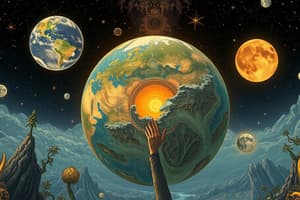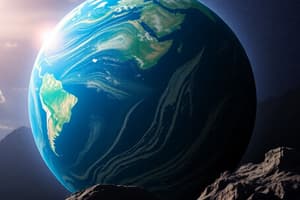Podcast
Questions and Answers
Which sphere is primarily responsible for providing breathable air and protection from harmful solar radiation?
Which sphere is primarily responsible for providing breathable air and protection from harmful solar radiation?
- Atmosphere (correct)
- Lithosphere
- Biosphere
- Hydrosphere
Which of the following is the most accurate description of the lithosphere's composition?
Which of the following is the most accurate description of the lithosphere's composition?
- The gaseous envelope surrounding the Earth.
- All living organisms on Earth and their interactions.
- The solid outer layer of Earth, including mountains, plains, and plateaus. (correct)
- The totality of Earth's water, including oceans, lakes and rivers.
Which of the following events demonstrates interaction between the atmosphere and the hydrosphere?
Which of the following events demonstrates interaction between the atmosphere and the hydrosphere?
- Formation of mountain ranges due to tectonic plate movement.
- Volcanic eruption releasing lava onto the Earth's surface.
- Heavy rainfall causing a river to overflow. (correct)
- The decomposition of organic matter in the soil.
Which of the following best describes the role of the biosphere?
Which of the following best describes the role of the biosphere?
What is the primary distinction between the lithosphere and the other Earth spheres?
What is the primary distinction between the lithosphere and the other Earth spheres?
Which geological process is LEAST associated with the lithosphere?
Which geological process is LEAST associated with the lithosphere?
What contributes most to the variance in the lithosphere's thickness?
What contributes most to the variance in the lithosphere's thickness?
If an area measures 60 km from the surface of the Earth, what would it most likely consist of?
If an area measures 60 km from the surface of the Earth, what would it most likely consist of?
From the options below, which is a characteristic of the lithosphere?
From the options below, which is a characteristic of the lithosphere?
What does the term 'lithos' represent in the context of the lithosphere?
What does the term 'lithos' represent in the context of the lithosphere?
If a scientist were to drill a borehole from the surface of the Earth to the core, which material would they encounter first?
If a scientist were to drill a borehole from the surface of the Earth to the core, which material would they encounter first?
Which statement accurately compares the physical properties of Earth's layers?
Which statement accurately compares the physical properties of Earth's layers?
Considering the volume percentages of Earth's layers, which conclusion can be drawn?
Considering the volume percentages of Earth's layers, which conclusion can be drawn?
What can be inferred about the origin of magma based on the description of Earth's interior?
What can be inferred about the origin of magma based on the description of Earth's interior?
How would the density change as you move from the crust to the core?
How would the density change as you move from the crust to the core?
Which atmospheric layer contains the ozone layer?
Which atmospheric layer contains the ozone layer?
What primarily causes the visible condensation trails (contrails) left by airplanes in the sky?
What primarily causes the visible condensation trails (contrails) left by airplanes in the sky?
Which process is responsible for transforming water from its liquid state in the ocean to a gaseous state in the atmosphere?
Which process is responsible for transforming water from its liquid state in the ocean to a gaseous state in the atmosphere?
What is the approximate height to which the atmosphere extends above Earth?
What is the approximate height to which the atmosphere extends above Earth?
What is the primary mechanism, within the water cycle, by which heat is transferred between the hydrosphere, atmosphere, and continents?
What is the primary mechanism, within the water cycle, by which heat is transferred between the hydrosphere, atmosphere, and continents?
Which of the following is a direct consequence of water transitioning from a gaseous state to a liquid state within the atmosphere?
Which of the following is a direct consequence of water transitioning from a gaseous state to a liquid state within the atmosphere?
Which layer of the atmosphere is closest to the Earth's surface?
Which layer of the atmosphere is closest to the Earth's surface?
What critical role does the presence of water in the atmosphere play regarding solar radiation?
What critical role does the presence of water in the atmosphere play regarding solar radiation?
Which of the following is a characteristic of the troposphere?
Which of the following is a characteristic of the troposphere?
What is the initial energy source that drives the process of evaporation in the water cycle?
What is the initial energy source that drives the process of evaporation in the water cycle?
Which geological process is primarily responsible for the formation of valleys?
Which geological process is primarily responsible for the formation of valleys?
What is the key differentiating characteristic between a plateau and a plain?
What is the key differentiating characteristic between a plateau and a plain?
Which of the following best describes the origin of many lakes in northern Quebec?
Which of the following best describes the origin of many lakes in northern Quebec?
What is the primary geological force behind the creation of mountain ranges?
What is the primary geological force behind the creation of mountain ranges?
How do shields differ from typical plateaus?
How do shields differ from typical plateaus?
Which of the following statements accurately describes the distribution of water within the hydrosphere?
Which of the following statements accurately describes the distribution of water within the hydrosphere?
Which of the following statements accurately describes the composition and state of Earth's core?
Which of the following statements accurately describes the composition and state of Earth's core?
If the total volume of water on Earth is represented by 'X', which expression best approximates the volume of readily accessible surface freshwater?
If the total volume of water on Earth is represented by 'X', which expression best approximates the volume of readily accessible surface freshwater?
How would a significant increase in global temperatures most directly impact the distribution of water within the hydrosphere, assuming no change in the total amount of water?
How would a significant increase in global temperatures most directly impact the distribution of water within the hydrosphere, assuming no change in the total amount of water?
At approximately what depth within the Earth does the temperature reach a point that is generally considered uninhabitable for most living organisms?
At approximately what depth within the Earth does the temperature reach a point that is generally considered uninhabitable for most living organisms?
Which of the following is the most accurate representation of the relationship between saltwater, freshwater, and accessible freshwater?
Which of the following is the most accurate representation of the relationship between saltwater, freshwater, and accessible freshwater?
What is the primary difference between the rocks in the upper mantle (close to the crust) and the deeper regions of the mantle?
What is the primary difference between the rocks in the upper mantle (close to the crust) and the deeper regions of the mantle?
Magma, which eventually erupts as lava from volcanoes, originates from which layer of the Earth?
Magma, which eventually erupts as lava from volcanoes, originates from which layer of the Earth?
Assuming that the total global freshwater resources remain constant, what would most likely happen if Quebec's freshwater resources were significantly depleted due to pollution or overuse?
Assuming that the total global freshwater resources remain constant, what would most likely happen if Quebec's freshwater resources were significantly depleted due to pollution or overuse?
What are the two primary types of crust that make up Earth's outermost layer, and what are their distinguishing features?
What are the two primary types of crust that make up Earth's outermost layer, and what are their distinguishing features?
What percentage of the air composition is made up of gases other than nitrogen and oxygen?
What percentage of the air composition is made up of gases other than nitrogen and oxygen?
Which of the following activities primarily relies on the presence of the atmosphere for human interaction?
Which of the following activities primarily relies on the presence of the atmosphere for human interaction?
At what altitude is air density the greatest compared to other layers of the atmosphere?
At what altitude is air density the greatest compared to other layers of the atmosphere?
What method do wind turbines use to produce energy?
What method do wind turbines use to produce energy?
Which aspect of the atmosphere is most critical for sustaining human life?
Which aspect of the atmosphere is most critical for sustaining human life?
What is the primary characteristic of the troposphere?
What is the primary characteristic of the troposphere?
Which layer of the atmosphere is known for absorbing most harmful UV rays?
Which layer of the atmosphere is known for absorbing most harmful UV rays?
In which layer of the atmosphere would you find shooting stars?
In which layer of the atmosphere would you find shooting stars?
What phenomenon occurs in the thermosphere?
What phenomenon occurs in the thermosphere?
What happens to temperature as altitude increases in the stratosphere?
What happens to temperature as altitude increases in the stratosphere?
Flashcards
Lithosphere
Lithosphere
The solid outer layer of Earth including mountains and plains.
Hydrosphere
Hydrosphere
All the water on Earth: oceans, lakes, rivers.
Atmosphere
Atmosphere
The layer of gases surrounding Earth, essential for life.
Biosphere
Biosphere
Signup and view all the flashcards
Interaction of spheres
Interaction of spheres
Signup and view all the flashcards
Core
Core
Signup and view all the flashcards
Mantle
Mantle
Signup and view all the flashcards
Crust
Crust
Signup and view all the flashcards
Volume Percentage
Volume Percentage
Signup and view all the flashcards
Temperature Gradient
Temperature Gradient
Signup and view all the flashcards
Earth's Internal Structure
Earth's Internal Structure
Signup and view all the flashcards
Magma
Magma
Signup and view all the flashcards
Earth's Crust
Earth's Crust
Signup and view all the flashcards
Upper Mantle
Upper Mantle
Signup and view all the flashcards
Geological Phenomena
Geological Phenomena
Signup and view all the flashcards
Variable Thickness
Variable Thickness
Signup and view all the flashcards
Relief
Relief
Signup and view all the flashcards
Plateau
Plateau
Signup and view all the flashcards
Shield
Shield
Signup and view all the flashcards
Mountain
Mountain
Signup and view all the flashcards
Valley
Valley
Signup and view all the flashcards
Troposphere
Troposphere
Signup and view all the flashcards
Stratosphere
Stratosphere
Signup and view all the flashcards
Mesosphere
Mesosphere
Signup and view all the flashcards
Thermosphere
Thermosphere
Signup and view all the flashcards
Ozone Layer
Ozone Layer
Signup and view all the flashcards
Evaporation
Evaporation
Signup and view all the flashcards
Condensation
Condensation
Signup and view all the flashcards
Precipitation
Precipitation
Signup and view all the flashcards
Water Cycle
Water Cycle
Signup and view all the flashcards
Role of Heat Transfer
Role of Heat Transfer
Signup and view all the flashcards
Condensation Trails
Condensation Trails
Signup and view all the flashcards
Proportion of Saltwater
Proportion of Saltwater
Signup and view all the flashcards
Proportion of Freshwater
Proportion of Freshwater
Signup and view all the flashcards
Sources of Freshwater
Sources of Freshwater
Signup and view all the flashcards
Scarcity of Freshwater
Scarcity of Freshwater
Signup and view all the flashcards
Composition of Air
Composition of Air
Signup and view all the flashcards
Air travel
Air travel
Signup and view all the flashcards
Recreational activities in air
Recreational activities in air
Signup and view all the flashcards
Wind turbines
Wind turbines
Signup and view all the flashcards
Air density
Air density
Signup and view all the flashcards



